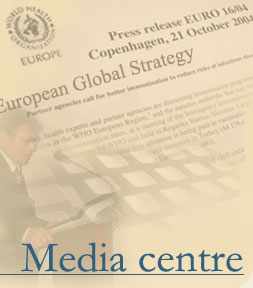World Health Day: Safe blood, used safely, saves lives!
WHO warns governments that, if their national blood programmes are inadequate, people's lives are at risk.
Copenhagen
Inadequate supplies of safe blood, the lure of cash payments for blood donation and the inappropriate use of available supplies are putting people’s lives at risk, warns WHO in a series of reports issued in conjunction with World Health Day.
“This year’s World Health Day theme, ‘Safe Blood Starts with Me’, is about public health rights and responsibilities,” says Dr Marc Danzon, WHO Regional Director for Europe. “People everywhere have the right to expect that their governments will take all steps necessary to ensure access to an adequate supply of safe blood when and where it is needed, and that their health professionals will be properly trained to use blood only when appropriate and when other alternatives will not answer. At the same time, WHO calls on all people to protect their own blood, to avoid high-risk behaviour, such as unsafe sex and intravenous drug use, and to come forth as voluntary, unpaid donors to contribute to the health of their fellow human beings.”
“The key blood safety priority for WHO in the European Region is to assist countries, where necessary, to establish health policies that will increase the number of low-risk, unpaid voluntary donors, especially in countries with high levels of HIV, hepatitis, syphilis and malaria, and to ensure mechanisms to improve the quality of care by reducing inappropriate blood transfusions and promoting the use of alternatives.”
Most transfusions are given to people injured in accidents, children with severe anaemia, surgical and cancer patients and women who lose large quantities of blood as a complication of pregnancy.
Countries in the eastern half of the European Region have special problems. In many eastern European countries, the incidence of infectious diseases such as syphilis has risen twenty- to fortyfold during the last few years, reaching a rate of 150–300 cases per 100 000 population (in western Europe the average rate is 1.5 per 100 000). These countries are also seeing many new cases of HIV. In some, donations of HIV-infected blood were up to 64 per 100 000 in 1998; in most other countries of the Region, the figure is 0.5 per 100 000 donations or below.
“Many of these countries still depend on paid blood donors. Financial and other ‘rewards’ for donation attract high-risk populations such as drug abusers and sex workers,” notes Dr Alex Gromyko of the WHO Regional Office for Europe. “This means that screening out unusable blood uses up scarce and expensive blood-testing resources. Also, since donors may have acquired HIV but may not have developed the antibodies to the virus, the risk of undetected infections is great.”
Worldwide, 5–10% of cases of HIV infection are transmitted through the transfusion of infected blood and blood products. Other major diseases that can be transmitted include viral hepatitis B and C, syphilis, malaria and Chagas disease. Globally, each year unsafe transfusion and injection practices cause an estimated 8–16 million hepatitis virus B infections, 2.3–4.7 million hepatitis virus C infections and 80 000–160 000 HIV infections.
WHO is working with national authorities and clinicians to promote blood safety and to reduce the spread of HIV and other infections through blood transfusion in all countries, especially those most in need, by advocating and assisting in the development of policies and infrastructures and the training of personnel. For example, a new set of Russian-language distance-learning materials on blood safety and the clinical use of blood was introduced to high-level ministerial representatives in 14 of the newly independent states of the former USSR last month.
Transfusion medicine specialists and clinicians with an interest in transfusion practice from across Europe will gather on 6–7 April in London, United Kingdom, under the auspices of the WHO collaborating centre at the National Blood Service (Birmingham), to agree on and issue recommendations to assist all European Member States in developing their own policies, in line with WHO guidelines, to reduce inappropriate blood transfusions and to promote the use of alternatives.
“Encouraging physicians to stop and think whether a transfusion is the best option is fundamental,” says Dr Gamal Gabra, head of the WHO collaborating centre and the principal coordinator of the meeting. “We want to alert governments to the need to look carefully at using blood, to have a national policy in place and to monitor quality and outcomes on a regular basis, making sure that the right product goes to the right patient at the right time without unnecessary overuse or underuse.”
“The experts will discuss a variety of recommendations,” notes Dr Isuf Kalo, WHO Regional Adviser for Quality of Care and Technology. “For example, the most senior person in the treatment team should make the decision to use blood and blood products. Clinicians should be encouraged to review and update their clinical principles on the use of blood, to minimize its use and to encourage alternatives or replacements, as part of a national policy on blood transfusion. Patients should be assessed carefully and on an individual basis, and all available alternative therapies explored before a decision is made. In addition, the experts will make specific recommendations for transfusion practice during and after childbirth and in emergencies.”
The final recommendations of the expert group will be forwarded to the WHO Regional Committee for Europe, which meets in September 2000 in Copenhagen.
For more information, contact:
|
|
|

